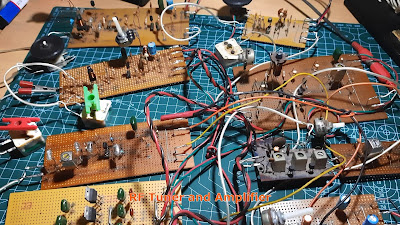An RF tuner and amplifier is a tuning and amplifying section connected to the input of a radio receiver or a communication receiver. The input of this stage is connected to the antenna and the output is connected to an RF mixer.
The addition of this section in a radio receiver is meant to tune and amplify the signals coming from the antenna before it is fed to the RF mixer stage. It helps to improve the gain, sensitivity and selectivity of a receiver.
The RF tuner and amplifier has two sections:
1. RF tuner section.
2. RF amplifier section.
RF Tuner:
The RF tuner section consists of a parallel tuned resonant circuit coupled to the antenna and its output is coupled to the RF amplifier stage. The resonant circuit is coupled to the antenna using a small value coupling capacitor. This section helps to tune to a narrow and selected range of frequencies from a wide radio frequency spectrum.
The higher Q factor of the tuning circuit helps to improve the signal to noise ratio. It helps to select a weak signal of a specific frequency from signals in the adjacent frequencies, thereby helping to avoid overlapping of signals. It prevents noise that is present in the adjacent radio frequency spectrum from entering into the input of a receiver. The quality or Q factor of the input tuned circuit that is tuned to the required frequency in superheterodyne receivers helps to reject the image signals from getting into the mixer stage and causing image interference. The resonant frequency of this parallel tuned circuit is determined by the formula, Fr = 1/2π√LC.
RF Amplifier:
This section consists of a common emitter transistor amplifier in a broadband configuration. The output of the RF tuner stage is coupled to the input of the RF amplifier. It amplifies the weak signals from the RF tuner stage and provides an amplified signal at its output. An RF gain control is provided for adjustment of RF gain, that helps to improve the reception of weak signals and it also helps to reduce the gain while receiving strong signals.
The amplifying device is a small signal low-noise device that has higher operating frequency. A broadband RF amplifier is used here that amplifies a wide range of frequencies covering most of the HF radio spectrum into the VHF range. The input and the output terminals must be sufficiently terminated to allow for maximum transfer of signals. An RF choke is used at the collector of the transistor, through which the output is coupled.
Applications of RF Tuner and Amplifier:
- The RF tuner and amplifier is used to selectively amplify weak signals from the antenna in radio and communication receivers.
- It is used as an RF preselector at the input of most general coverage radio receivers that helps in the reception of weak signals in the medium frequency (MF), high frequency (HF) and very high frequency (VHF) bands.
- It significantly reduces the adjacent signal interference and image reception problems in superheterodyne receivers.
- It is used as an input preselector section in radio frequency converters.
- It considerably strengthens the signals from the antenna in software defined radios.
- It improves sensitivity and selectivity to radio signals in broadcast radio receivers.





No comments:
Post a Comment